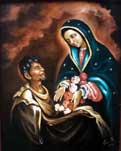The story that helped convert Mexico’s native population
- Details
- Published on Friday, 06 December 2013 12:49
- Written by GR Staff
 The cult of the Virgin of Guadalupe emerged in the early 16th century, only a decade after the fall of the Aztec empire, with her legendary apparitions on the hill of Tepeyac at the outskirts of the newly founded capital of New Spain.
The cult of the Virgin of Guadalupe emerged in the early 16th century, only a decade after the fall of the Aztec empire, with her legendary apparitions on the hill of Tepeyac at the outskirts of the newly founded capital of New Spain.
As the story goes, it was there, on December 9, 1531, that an Indian newly baptized into the Christian faith with the name Juan Diego was stopped in his tracks by a blinding light and the sound of unearthly music. Before him appeared an astounding vision – a beautiful dark-skinned woman who spoke to him in his native tongue. Calling him “my son,” she told Juan Diego she was the Virgin Mary, mother of Jesus Christ. She said it was her desire to have a church built on that very spot and she asked the Indian to convey that message to Bishop Juan de Zumarraga.
It was no easy task for a humble Indian to gain an audience with the top prelate, but Juan Diego persisted until he was received and given the opportunity to report his experience. The incredulous Bishop responded by demanding further evidence of the unlikely encounter.
On December 12, while rushing to find a priest to attend a seriously ill uncle, Juan Diego took a short cut across Tepeyac. The Virgin once again appeared and Juan Diego told her of the Bishop’s request. The Virgin instructed him to climb the usually serene and desolate hill to collect Castilian roses – at the time unknown in the new world – and deliver them to Zumarraga as the sign.
Juan Diego gathered up the rare blossoms in his mantle and hurried off to complete his mission. Once again before the Bishop, he let the roses spill out at his feet. To the wonder of all assembled, a splendid image of the Virgin Mary was revealed emblazoned on Juan Diego’s cloak.
By order of the Bishop, a small church was soon constructed on the site designated by the Virgin. By no small coincidence it was where an Aztec temple dedicated to the earth goddess and mother figure Tonantzin had stood before being razed by the Spaniards. Scholars who have studied the subject suggest that Spanish missionaries promoted the cult to Guadalupe as a substitute for Tonantzin as a means to ease the conversion of the native population. An alternate theory points to the hidden perpetuation of native beliefs through worship of a Chrisianized form of the Indian goddess.
The Vatican officially recognized the Miracle of Guadalupe in 1745. Her first sanctuary was replaced over the years by increasingly larger structures. The elegant colonial style church completed in 1709 was declared a Basilica in 1904, but by then the building had begun sinking into the soft, sandy soil beneath it. A new Basilica, of modern design and enormous capacity, was dedicated in October 1976.
The site currently draws around 15 million pilgrims every year, making it the one of the most popular Roman Catholic sanctuaries on the planet, rating second only to St. Peter’s Basilica in Rome. Like other churches dedicated to the Virgen de Guadalupe, it will be a magnet for thousands who will gather over the next few days to venerate La Reina de Mexico (the Queen of Mexico) with pilgrimages and processions, prayers and services, songs, dances, music and fireworks.
Juan Diego was canonized as a Catholic saint in 2002.
























